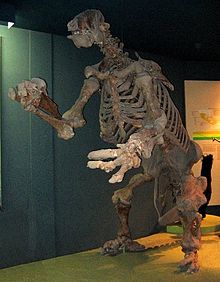This led me to the term bipedalism, which is a form of locomotion on two feet, which humans and many mammals, primates, and amphibians do. Bipedalism is described as having several types of movement, including standing, walking, running, and jumping. There were several mammals described to have evolved independently into bipedalism as their primary way of moving, which is where one particular mammal listed caught my eye...a sloth.
But this was not just any sloth; in fact, it was an extinct ground sloth, also scientifically known as a Megatheriidae. These sloths lived up until 11,000 years ago primarily in South America. Their skeletal remains indicate that they were absolutely massive (which made me excited and laugh a lot) with reports of one of the earliest ones being 17 feet tall, 6 meters in length, and 5 tons in weight. I just about lost it when I read that portion because I love sloths and I instantly googled images of these beautiful creatures.
Megatheriidae received their name ("great beast") from Georges Cuvier, so my final stop on the Wikipedia trail was learning more about him. Cuvier was a French naturalist and zoologist and one of the founding fathers of palaeontology. He essentially established the field of comparative anatomy and taxonomy grouped into classes of phyla. He also did not believe in evolution and engaged in public debates about the topic.
(Skeleton of the MASSIVE extinct ground sloth)
Source: Wikipedia

No comments:
Post a Comment